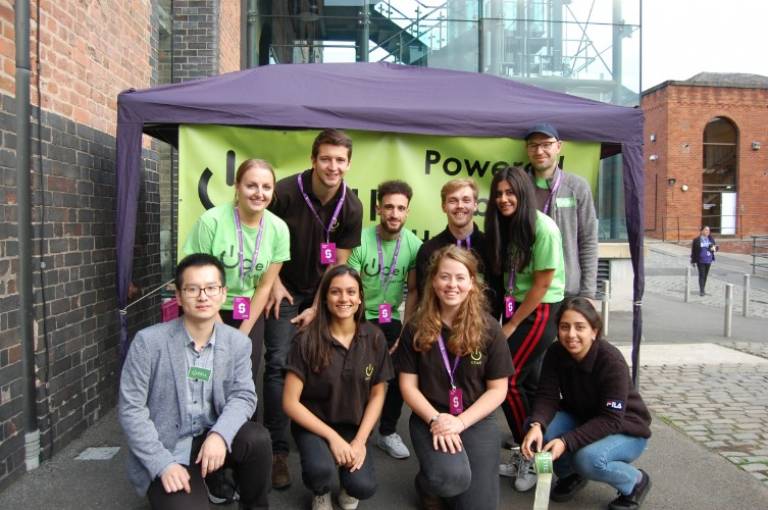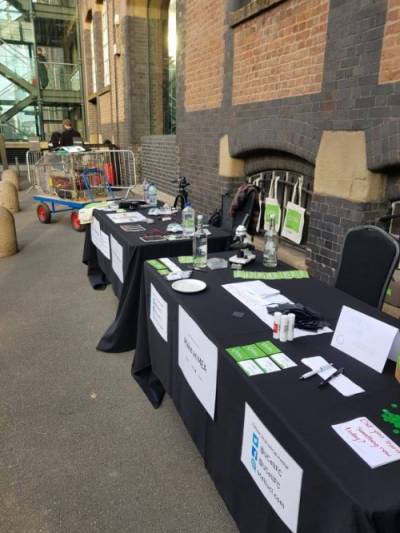UCell@Manchester Science Festival 2018
31 October 2018

UCell have a long history of attending science festivals, with previous events attended including Cambridge Science Festival and Bury St Edmunds Science Festival, and this October saw another one being added to the UCell calendar. This was the first time that the stack had ventured North of the M6 Toll and after months of preparation and organisation, on Friday 19th October we made the journey to Manchester to take part in the “Power Playground” part of the Manchester Science Festival. The science festival takes place over 10 days, with events all over the city and is one of the biggest science festivals in the UK. The Power Playground was a two day extravaganza taking place in the Science and Industry Museum and the theme of the event was “Electricity”. When reading our application, the event organisers thought we would be a perfect fit considering we could make electricity from hydrogen for the whole weekend! This particular event was mainly focused on fuel cells and electrolysers, but there were other stands at the festival devoted to all things battery, as well as a group who use VR for assessing offshore wind turbines.

Saturday morning at 8am and it was all hands on deck to get our event set up. Our event comprised of three main activities: first was a “Make your own fuel cell” make-and-take activity aimed at young children, where they could stick their own components of a fuel cell together and take it away. This was to allow visitors to understand more about the internal workings of a fuel cell. There was also a small microscope, where visitors could see some fuel cell materials under magnification, like the gas diffusion layer – a key component of the membrane electrode assembly at the heart of the fuel cell. Secondly, the visitors could see the fuel cell demo kit cars in action, to understand more about the science of fuel cells and electrolysers. The third activity was a new addition to our toolbox of demos and was the “UCell-fie” instant photo printer. Thanks to a grant we obtained from UCL earlier in the year, we were able to buy a whole host of new kit, including a portable instant printer that could print out selfies of visitors taken with the thermal camera. People were especially amazed to find out that their selfie was powered only by the hydrogen and air that was being supplied to the operating stack. As well as the new activities, we had UCell-branded pens, stickers and tote-bags to give away to visitors, with and also feedback boxes and counters on the table so that people could tell us what they thought of our event. Altogether, the range of goodies on offer really helped to make our stall feel really professional!
Once setup was complete, visitors started to arrive at the museum and the stall got busier. Our event was positioned outside in the Upper Yard of the science museum, with the gas bottles stored in a locked cage and kept at least 5 m from the stack and the rest of our stall. Contrary to popular belief about the relentless rain in Manchester, we didn’t have any until midday on Sunday! This was a relief, because it meant that many visitors were passing our stall on their way around the museum. Saturday saw several girlguiding and scouting groups coming to the museum – it was great to see that they had been brought specially to the Science and Industry Museums to take part in the Power Playground. All of the children and leaders particularly liked the fact that they could take a UCell-fie back to their guide/scout huts and show the others what they had learnt at the museum.
We were kept busy all day between 10am and 5pm and we were thankful for having a 10-strong team, with 5 women and 5 men, to ensure that everyone could get sufficient breaks! We also had a collaborator, Mike, come and join us for a while on both Saturday and Sunday. Mike runs Planet Hydrogen, a group of people who are passionate about the hydrogen economy and campaign to spread the word of hydrogen from their base in Manchester.

Sunday kicked off in a similar fashion. Although the day was slightly quieter than the Saturday, the flow of visitors didn’t let up and we still had many interesting discussions.
Unfortunately rain stopped play outside around midday on the Sunday and, despite our gazebo, we decided to shut down the stack and move everything inside. This wasn’t a problem, though, because from our indoor space we could continue our intersting discussions with visitors. A favourite conversation was with a woman and her daughter: we were discussing how fuel cell and electric vehicles are so quiet and that sounds have to be engineered into the vehicles so that people can hear them coming. The girl then asked if the car could play music through external speakers – she quite liked the idea of being able to blast out Lady Gaga when driving along!
At 5pm the museum closed and we speedily packed up the event – 10 pairs of hands really do make light work! Thankfully the roads back to London were much quieter and the journey back home went nice and smoothly.
Although it was a long way to go, the event was definitely worth attending. It was great to be able to engage with a whole new group of people, as well as to meet other researchers from around the UK who are working in related areas. A huge thanks also go to the event organisers for having us along at the museum, we hope that we are able to attend again in future! Finally, the fact that we could take the stack over 200 miles, just highlights the portable nature of the system. Who knows, maybe in the future we will be transporting it in a fuel cell van?
 Close
Close

